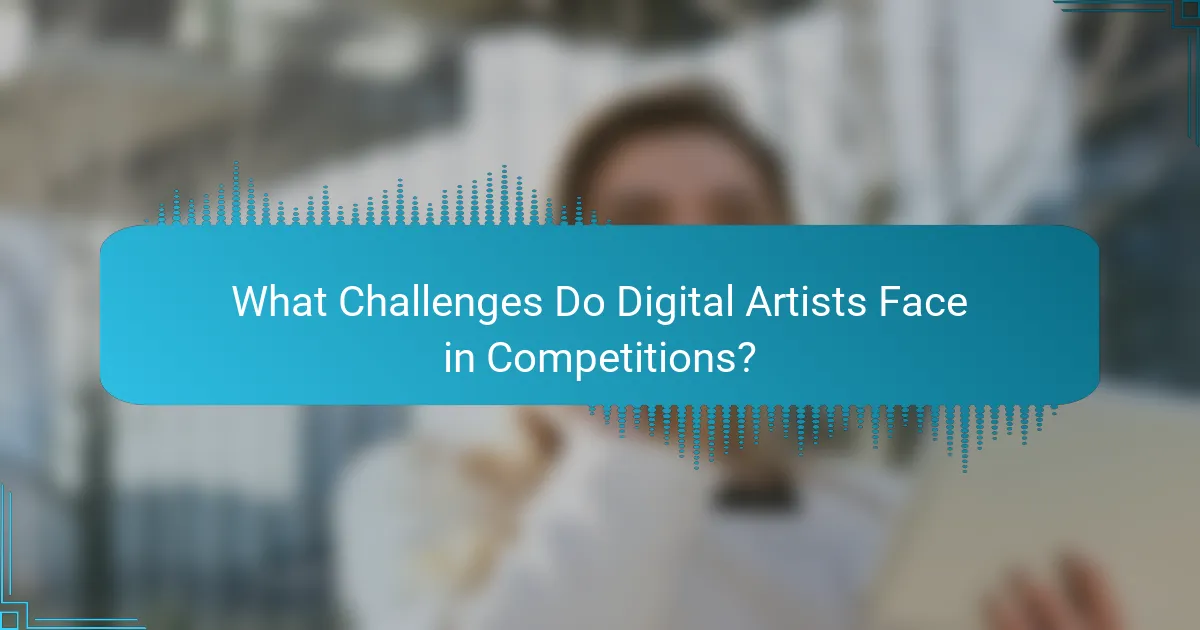Digital art platforms for competitions offer artists a unique avenue to display their creativity, gain visibility, and compete for valuable prizes. By participating in themed challenges, artists can connect with a community of peers while navigating the complexities of market saturation and technical demands. These platforms not only foster artistic growth but also present essential networking opportunities that can enhance an artist’s career.

What Are the Best Digital Art Platforms for Competitions?
The best digital art platforms for competitions provide artists with opportunities to showcase their work, gain recognition, and potentially win prizes. These platforms often feature community engagement, submission guidelines, and varying levels of exposure based on the competition’s prestige.
ArtStation
ArtStation is a leading platform for digital artists, particularly in the gaming and entertainment industries. It hosts regular competitions that attract top talent, offering prizes such as cash, software licenses, and portfolio reviews.
To participate, artists typically need to create an account, follow the competition guidelines, and submit their work by the specified deadline. Engaging with the community through comments and feedback can enhance visibility and networking opportunities.
DeviantArt
DeviantArt is one of the largest online art communities, featuring a variety of competitions ranging from themed challenges to seasonal contests. Artists can submit their work directly on the platform, often with specific themes or criteria outlined for each competition.
It’s beneficial to actively participate in the community by commenting on others’ work and joining groups, as this can increase the chances of gaining attention for your submissions. Prizes may include cash, merchandise, or features on the site.
Behance
Behance is a platform that showcases creative work across multiple disciplines, including digital art. While it is less focused on competitions, it does host curated challenges that allow artists to gain exposure and connect with potential employers.
Artists can submit their projects to these challenges, and standout submissions may be featured on Behance’s main page or social media channels. Networking with other creatives and promoting your work can enhance your chances of recognition.
Dribbble
Dribbble is a community for designers and digital artists, known for its focus on showcasing work rather than hosting formal competitions. However, it does feature design challenges that encourage creativity and innovation.
To participate, artists can upload their shots and tag them according to the challenge. Engaging with the community through feedback and collaboration can lead to opportunities for freelance work and networking.
CGSociety
CGSociety is a platform dedicated to computer graphics and digital art, hosting various competitions that cater to 3D artists, illustrators, and concept artists. These contests often come with substantial prizes and recognition within the industry.
Artists should carefully read the competition rules and submission requirements, as they can vary significantly. Participating in forums and discussions can also help in gaining insights and improving skills, making submissions more competitive.

How Do Digital Art Competitions Work?
Digital art competitions provide artists with opportunities to showcase their work, gain exposure, and potentially win prizes. Participants typically submit their creations based on specific themes or prompts, which are then evaluated by a panel of judges or through public voting.
Submission Guidelines
Submission guidelines vary by competition but generally include requirements for file formats, dimensions, and themes. Artists should carefully read the rules, as some contests may specify digital mediums, such as 2D illustrations or animations, while others may allow a broader range of styles.
Most competitions require participants to submit their work by a certain deadline, often through an online portal. It’s advisable to keep track of submission dates and ensure that all files meet the specified criteria to avoid disqualification.
Judging Criteria
Judging criteria typically focus on creativity, technical skill, and adherence to the theme. Judges may look for originality and the emotional impact of the artwork, as well as the overall execution and presentation.
Some competitions also incorporate public voting, where audience engagement can influence the final results. Understanding the judging process can help artists tailor their submissions to align with what judges are looking for.
Prizes and Recognition
Prizes in digital art competitions can range from cash awards to software licenses, art supplies, or exhibition opportunities. Recognition can also include features in online galleries, social media shout-outs, or inclusion in art publications.
Winning or even placing in a competition can significantly boost an artist’s visibility and credibility in the art community. It’s beneficial to research past winners and their experiences to understand the potential impact of participating in these contests.

What Challenges Do Digital Artists Face in Competitions?
Digital artists encounter several challenges in competitions, including market saturation, the need for advanced technical skills, and limited networking opportunities. These factors can significantly impact their ability to stand out and succeed in a crowded field.
Market Saturation
The digital art landscape is highly competitive, with numerous artists vying for attention in various competitions. This saturation makes it difficult for individual artists to differentiate themselves and gain recognition for their work.
To navigate this challenge, artists should focus on developing a unique style or niche that sets them apart. Engaging in themed competitions or collaborating with other artists can also help increase visibility and showcase distinct artistic voices.
Technical Skills
Competitions often require a high level of technical proficiency in digital art tools and software. Artists must continuously update their skills to keep pace with evolving technologies and trends in the industry.
Investing time in online courses or tutorials can enhance technical abilities. Additionally, practicing regularly and experimenting with new techniques can help artists improve their craft and meet competition standards.
Networking Opportunities
Limited networking opportunities can hinder digital artists from connecting with industry professionals and peers. Building relationships is crucial for gaining insights, feedback, and potential collaboration in competitions.
Artists should actively participate in online forums, social media groups, and local art events to expand their network. Joining art collectives or attending workshops can also facilitate valuable connections that may lead to future opportunities in competitions.

What Opportunities Exist for Digital Artists?
Digital artists have a variety of opportunities to showcase their work and earn income. These include collaborations with brands, freelance projects, and participation in online courses and workshops that can enhance their skills and visibility.
Collaboration with Brands
Collaborating with brands allows digital artists to create unique content that aligns with a company’s marketing goals. This can involve designing graphics for social media, creating promotional materials, or even developing custom artwork for products.
To find collaboration opportunities, artists can network through social media platforms like Instagram or LinkedIn, where many brands seek creative talent. It’s essential to build a strong portfolio that showcases versatility and style to attract potential partners.
Freelance Projects
Freelancing offers digital artists the chance to work on diverse projects across various industries. Artists can find gigs on platforms like Upwork or Fiverr, where they can bid on jobs that match their skills.
When taking on freelance work, it’s crucial to set clear terms regarding payment and deadlines. Artists should also be prepared to negotiate rates, which can vary widely based on experience and project complexity, typically ranging from $20 to $100 per hour.
Online Courses and Workshops
Online courses and workshops provide digital artists with opportunities to learn new techniques and improve their craft. Platforms like Skillshare and Udemy offer a range of classes, from beginner to advanced levels, often at affordable prices.
Participating in these educational opportunities can enhance an artist’s skill set and increase their marketability. It’s advisable to choose courses that offer hands-on projects and feedback from instructors to maximize learning outcomes.

How to Choose the Right Competition for Your Art?
Selecting the right competition for your art involves assessing your goals, the competition’s theme, and the potential exposure it offers. Consider factors like entry fees, prize structures, and the reputation of the organizing body to ensure it aligns with your artistic vision and career aspirations.
Understand Your Artistic Goals
Before entering a competition, clarify what you hope to achieve. Are you looking for exposure, feedback, or monetary rewards? Understanding your objectives will help you choose competitions that align with your aspirations, whether it’s showcasing your work or gaining recognition.
Research the Competition’s Theme
Each art competition typically has a specific theme or focus. Ensure that your work fits within these parameters to increase your chances of success. For instance, if a competition emphasizes environmental themes, submitting a piece that reflects this focus can enhance your relevance.
Evaluate Entry Fees and Prizes
Entry fees can vary widely, from free submissions to several hundred dollars. Weigh the cost against the potential benefits, such as cash prizes, exhibition opportunities, or exposure to industry professionals. A competition with a modest fee but significant rewards may be worth considering.
Check the Organizers’ Reputation
The credibility of the competition organizers can impact your experience and the value of the competition itself. Look for competitions hosted by well-known galleries, art institutions, or reputable organizations. This can enhance your portfolio and provide networking opportunities.
Consider the Exposure and Networking Opportunities
Some competitions offer more than just prizes; they provide platforms for networking and exposure. Investigate whether the competition includes exhibitions, online showcases, or connections to industry professionals. These opportunities can be invaluable for your artistic career.
Review Past Winners and Their Experiences
Research previous winners to gauge the competition’s impact on their careers. Look for testimonials or case studies that illustrate how winning or participating has benefited them. This can provide insight into the competition’s value and help you make an informed decision.


